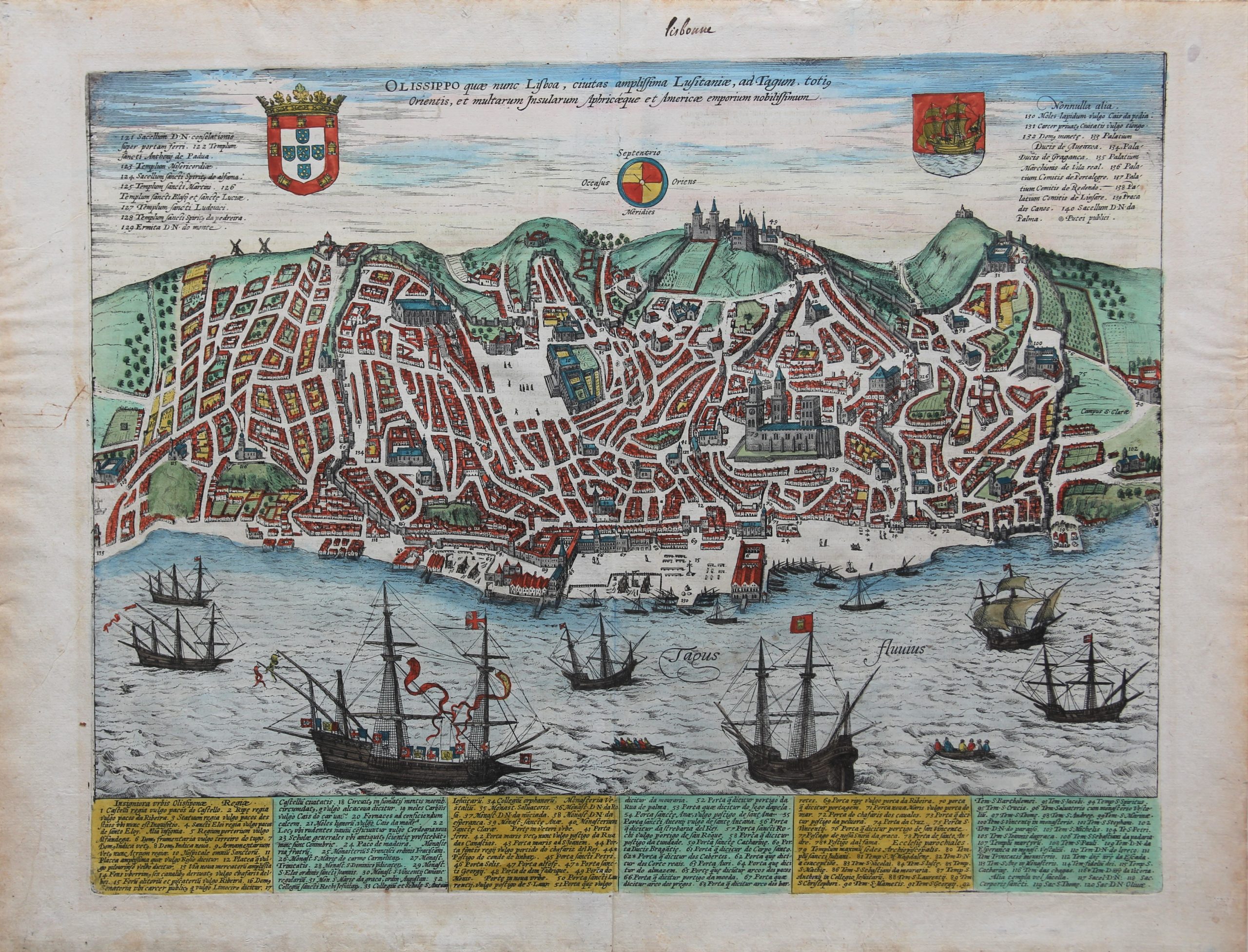Lisbon
Detail
Date of first edition: 1596
Date of this edition: ca. 1598
Dimensions (not including margins): 36,5 x 47 cm
Dimension (including margins): 42,5 x 55, 8 cm
Condition: Good, strong copper engraving with superb original coloring. Wide margins. General slight age-toning and signs of previous framing.
Condition rating: A
Verso: text in Latin
Map reference: Van der Krogt 2399 (second state); Taschen, Br. Hog., p. 346
From: Civitatis Orbis Terrarum (Urbium praecipuarum mundi theatrum quintum, first edition 1596, this edition probably 1598), Köln. Van der Krogt 41:1 or 41:2-3, page 2
The second state has keys in Latin 1 to 140 (first state 1 to 120). The second state is the compass rose finished, which was not so in the first state.
In stock
Lisbon commented by Braun
“In historical times there where two cities we might call “Ruler of the oceans and the high seas”, from where ships could set sail for the East and the West: one is Seville, the other Lisbon. […] Lisbon is one of three episcopal cities within the Kingdom of Spain, whose main church, the Catedral Se Patriarcal, is magnificently decorated and worth seeing.”
Original title: – Olissippo quae nunc Lisboa, Civitatas Amplissima Lustinaniae…
Translation of caption: Olisippo, which is today called Lisbon, the largest city of Lusitania, situated on the Tejo. The most moted centre of trade for the entire Orient, for many islands, for Africa and America.
Taschen on Lisbon
The combination of side view and bird’s-eye view emphasizes the city’s geographical situation. A legend allows us to identify famous buildings such as the Castelo de São Jorge (1) on the skyline, which was conquered by the Moors early on, in the 8th century AD, and restored to Portuguese possession by Alfonso I as late as 1147. Today the ruined fortress offers the best view of the city. Beneath it lies the Romanesque and Gothic cathedral of Se Patriarcal (79). Lying immediately beside the Tejo is the Lower Town of Baixa, bounded by the hill bearing ther fortress and the Upper Town of Bairro Alto. As two-thirds of Lisbon was destroyed by an earthquake on 1 November 1755, the illustrations in the Civitates orbis terrarum provide important records of the city’s former appearance. After the earthquake, the Lower Town was rebuilt in the style of the 18th century.
On the River Tagus: The Tagus is the longest river in the Iberian Peninsula. It is 1,007 km (626 mi) long, 716 km (445 mi) in Spain, 47 km (29 mi) along the border between Portugal and Spain and 275 km (171 mi) in Portugal, where it empties into the Atlantic Ocean near Lisbon. Thus, it links Toledo to Lisbon!
Related items
-

Algarve – Beschrijvinghe der Zee Custen vant Landt va Argarbe
by Lucas Janszoon WaghenaerPrice (without VAT, possibly to be added): €2 250,00 / $2 497,50 / £2 002,50 -

Portugal – Portugalliae que olim Lusitania…
by Abraham OrteliusPrice (without VAT, possibly to be added): €700,00 / $777,00 / £623,00 -

Coimbra – Illustris Civitati Conimbriae In Lusitania ad flumen Illundam effigies
by Georg Braun and Frans HogenbergPrice (without VAT, possibly to be added): €750,00 / $832,50 / £667,50A picturesque Portuguese university city













